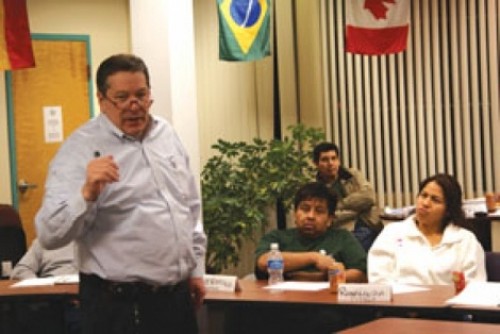News | Peso Power: A unique program teaches Mexican immigrants how to develop home communities in Mexico
By Eric S. Peterson @ericspetersonImmigrants for the first time in Utah can take advantage of the “three-for-one” program, which allows them to send money back to their home communities and receive matching funds from the Mexican government on federal, state and municipal levels. Latino advocates in Utah hope the program will help solve a big problem: preventing immigrants’ countrymen from crossing the border to the United States in search of work by creating jobs in Mexico.
In 2006, immigrants in the United States sent $45 billion in remittances back to mostly poor, rural areas of Mexico. While most was simply money sent from one family member working in the United States directly to family back home, the three-for-one program created in 2002 allows matching funds for remittances if they help to develop a community’s infrastructure.
“The workshops we are running now focus on developing projects that will create jobs in Mexico,” says Raul Vargas, vice president of the Centro Civico Mexicano de Utah. “We think it’s important to make investments in Mexico so that people won’t have to try and come here if they don’t have papers.”
Utah’s immigrant “clubs” organized by members’ Mexican communities of orgin all have unique pet projects for their home villages. Some plan to capitalize on their cross-border connections. “Several groups from Guanajuato and Puebla, for example, will have farms produce vegetables they will then try and sell in the U.S.,” Vargas says. Other groups plan to produce and try to market Mexican handicrafts like wallets and artisan gifts for sale in Utah.
The success of the Mexican government-initiated three-for-one program is fairly spectacular, considering Mexico’s own history of government corruption and the public distrust of any supposed government “antipoverty” initiative. But the three-for-one program is different.
After certifying the project, the only influence the Mexican government has is in providing matching funds to the community project. What the project does and how it’s run is left in the hands of community members. “The three-for-one program makes the government more accountable,” Vargas says. “It’s a great opportunity for Mexican communities to sit down with the government and be able to say, ‘Hey, you have to do this.’ In this way, we don’t just help out the poor, we also develop the power of the people.”
The intensive 12-week workshop in Salt Lake City helps club leaders not only develop their project ideas, it also helps them become financially literate.
Gonzalo Palza, director of the Centro de la Familia de Utah, teamed up with Vargas in the project to lead the weekly workshops and, as the “headmaster,” is very proud of the community. “These are some of the most productive people in our community,” Palza says of the class of working-class adult Latinos, “and this is one of the only resources for them.”
Palza is happy to facilitate the three-for-one program but mostly hopes to instill a strong business sense in the community. He is no stranger to the corporate world. Before taking over as the director of Centro de la Familia, Palza worked 18 years as an executive for United Technology—a $30 billion-plus global corporation.
During the class, Palza paces up and down the floor and questions the class on their projects. A young farmer from Puebla tells of trying to get rural farmers to stand up to local acaparadoras, mafia-like agricultural hoarders in Mexico who bully farmers into selling them their produce for next to nothing, then turn around and sell them in city markets at inflated prices. Palza leaps on the story, making a point about investigating risk and conducting cost-benefit analyses. Another farmer from Guanajuato talks of difficulties keeping asparagus fresh while it’s exported to American markets, and Palza drills the class on what quality and customer satisfaction mean on a fundamental level.
“We treat each idea as a case study,” Palza says. “Everyone is encouraged to share apprehensions and ideas about each others’ projects, in a safe environment.”
Salvador Lazalde, a longtime Zacatecas club president, has been organizing the building of a road and a hotel back home to cash in on tourists visiting hot springs in the area, is excited by the Utah workshop.
“I’ve been doing this for many years,” Lazalde says, “and there is no project like this anywhere. Not in California or Chicago. We have so many representatives from communities throughout Mexico here together to work on their projects; it’s very exciting.”
Palza and Vargas reap their greatest rewards in teaching the groups financial literacy—whether it’s through developing communities in Mexico, personal businesses in Utah or even skills like investing, banking and avoiding predatory lenders when buying homes.
“Our population here is very dedicated,” Palza says. “They work hard just to make a living and take care of their families. They’re very noble in their efforts.”
More by Eric S. Peterson
-
The Secret Sauce
How Utah lawmakers disclose—or don't disclose—conflicts of interest.
- Feb 14, 2024
-
Police departments in Salt Lake County spent almost $20 million on civil rights complaints in the past decade
The Co$t of Mi$conduct
- Oct 18, 2023
-
Women decry harassment and toxic culture at St. George auto dealership
Men at Work
- Oct 11, 2023
- More »
Latest in News
Readers also liked…
-
Raise a glass for E.L.T Harrison, architect of the Beerhive building on Main
Small Lake City
- Oct 11, 2023





